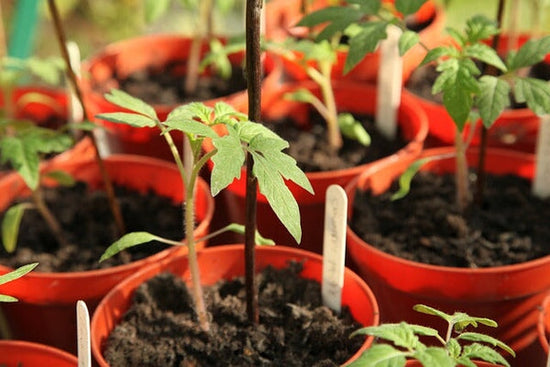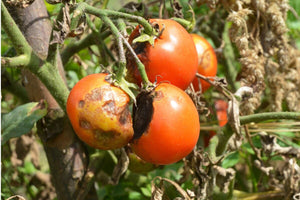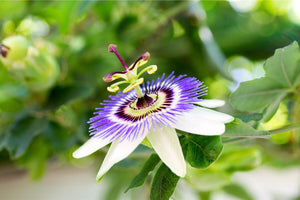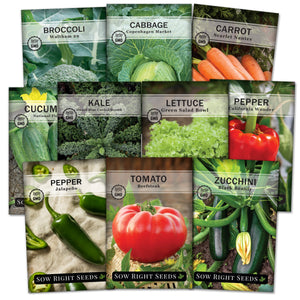Know When to Transplant Seedlings: Signs to Check. Steps to Take.
Beginner gardeningOnce your indoor seedlings are mature enough, it's time to transplant them outside. But what if you haven't transplanted seedlings before? How do you know when they are ready and what you should do? Don't worry. We'll walk you through the process of moving those tender plants into their new home.

When to Transplant Seedlings Outdoors
Starting your seeds indoors and moving them out to the garden is a fun, rewarding process. Once your seeds have germinated and started to grow into healthy seedlings, you'll feel some excitement and think you're almost there!
It's important to know when it's the right time to transfer your seedlings. Getting the timing right will be the difference between vigorous plants and stunted growth.
For our purposes, this article will focus on when to transplant seedlings outside. Our article about potting up covers moving seedlings from seed trays into larger containers while keeping them inside.
- When transplanting seedlings, they need to have at least two sets of true leaves. These leaves are different than the seed leaves or cotyledons. These true leaves will have the shape of mature leaves even though they are still small.
- The other sign to check is healthy roots. Since outdoor conditions can be harsher than indoors, the young plants must have a strong enough root system to live outside.
- Another consideration for transplant timing is the plant variety. Some plants, such as broccoli and cabbage, can withstand cooler temperatures and will produce better crops when transplanted as tender seedlings. Tomatoes and peppers, on the other hand, can benefit from more time indoors and being potted up.
- Always pay attention to which plants cannot tolerate frost and delay transplanting until all danger of frost has passed.
Even though you may be excited about getting those plant babies into the ground, make sure they are ready, so they will continue to have healthy growth.

How Do I Transplant My Seedlings into the Garden?
When done correctly, transplanting into the garden will be an exciting time. These steps will ensure your tender seedlings transition well and minimize transplant shock. When you follow these steps, there's no need to worry about the process.
1. Harden off your seedlings
To get ready to move your plants fully outdoors, start hardening off your plants so they'll be ready for their new spots in the garden. You'll start the hardening-off process once your seedlings have three or four true leaves and right before outdoor conditions are ideal for growing that particular type of plant. This is a crucial step for avoiding transplant shock.
2. Prepare the garden
While you wait for your plants to become used to the outdoor environment, you’ve got about two weeks to start preparing your garden for new plants. Make sure the space is clear of weeds and rocks. You may need to test your soil and add any amendments that your soil needs for optimum plant growth. Make sure the soil is moist but not saturated when it’s time to transplant.
3. Choose Your Transplant Day
It’s best to transplant on a calm, cloudy day, if possible, with mild weather conditions. If the weather simply isn’t cooperating, transplanting in the late afternoon or early evening will work, too. You want to give your plants cooler temperatures and a chance to settle in properly before being exposed to bright morning sunlight.

4. Transplanting Individual Seedlings
- Choose the sturdiest, healthiest plants to transplant, and handle them with care. Water plants well about an hour before transplanting.
- When you're ready, gently remove the seedling from the container, taking care not to harm the roots. Try to handle your plants by the leaves, not the stem. This might seem a little counterintuitive, but the reason for this is that a damaged leaf is much easier for the plant to replace than a stem.
- If your plants are in one container, cut between the roots, so each plant has a distinct root ball.
- Transfer each plant into a hole that is deep enough to easily hold the root ball without crowding or stuffing it into a hole. Press the soil in around the roots to get rid of air pockets.
- If you're using peat pots, make sure the hole is deep enough to fully cover the rim of the peat pot to keep the pot from wicking moisture away from the roots.
- When transplanting tomatoes, dig a couple of inches deeper to bury the base of the stem. Two or three sets of true leaves should be above the ground.
- Water and fertilize with an appropriate starter solution.
And that's it! You've taken your plants from seed to the garden. Stand back and enjoy the work you've done so far. The fun is just beginning!
For more information on growing flowers, herbs, and vegetables, look at our growing guides in our Planter's Library.
Transplanting FAQs
How big should seedlings be before transplanting?
A good rule of thumb is that seedlings should be several inches tall with at least 3 true leaves before transplanting.
What happens if you transplant seedlings too early?
If seedlings are transplanted too early, they can have stunted growth caused by stress. When I transplanted pepper and tomato plants too early, the cold weather set them back, and they were weeks behind the plants that were kept inside longer.
How long can seedlings stay in trays?
Seedlings need to be moved into larger pots or into the garden before they become root-bound.
Sources:
Starting Plants Indoors From Seeds - University of Missouri Extension
Transplanting Annuals into the Garden - PennState Extension
How and When to Transplant Seedlings Into the Garden - Gardening Know How
Written by Teresa Chandler







Leave a comment